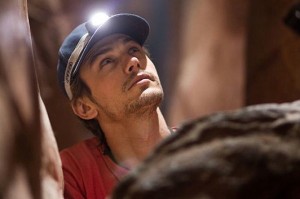More thoughts on this year’s Best Picture nominees. I’m writing with the assumption that readers have seen the films in question, so please beware of spoilers. Other posts in the series can be found here.
127 Hours
If The King’s Speech is a castration run in reverse — the restoration of potency after a lifelong absence — 127 Hours offers up this most basic of phallic dramas in its correct, fated order: a gathering dread that culminates in a foundational wounding. (As in most psychodynamics, of course, time’s arrow is rarely straightforward: castration, like the primal scene, can only ever be retroactively experienced, trauma reconstructed in phantasy.) Knowledge of what is to come colors the entire film; the self-amputation performed by Aron Ralston (James Franco) awaits us at the end of the narrative like Shelob in her lair, and the sunny boisterousness of the rest of the movie (at least as it’s been shot and edited) seems like a long innoculation against those inevitable minutes of agony.
And what beautifully rendered agony it is! Movies are getting good at this lately — the stimulation of our pain centers via optical and audio channels, torture at a distance. (I blame, and thank, pornography.) The Passion of the Christ (Mel Gibson, 2004) still holds the record for the most lovingly conceptualized and rhapsodically paced destruction of an onscreen body, a four-course feast of suffering served up in more efficient form by the Saw franchise (2003-present) with the reliable abundance of fast-food burgers sliding down their stainless-steel troughs. Japanese guinea-pig films worked out much of the cinematic algebra involved, but it is in the French “new extreme” movement, specifically À l’intérieur (Julien Maury and Alexandre Bustillo, 2007) and Martyrs (Pascal Laugier, 2008), that we find this movie’s closest conceptual cousins, exploring the ways in which the visitation of unspeakable violence upon an avatarial stand-in for the spectator results in a kind of mutual apotheosis. As Aron, starved, dehydrated, and bleeding, stumbles out of his death trap, so we leave the theater cleansed, reborn. Having seen ourselves torn apart in the mirror of the movie, we appreciate anew the intactness of our limbs.
Being antisocial myself, I resent the way in which Ralston’s trials have been framed as a kind of punitive purgatorial isolation — the price of his disconnection from society. Ten years after 9/11, apparently, it’s become a bad thing to be a hero (the term used more than once not to praise but to chastise the self-sufficient outdoorsman), and the paneled montages of bustling crowds that open and close the movie read not as condemnations but celebrations of what I can only, in my own grumpy solitude, label herd security: endorsement of the arrival-gate fuzzies of Love Actually (Richard Curtis, 2003) over the misanthropic kaleidoscope of Koyaanisqatsi (Godfrey Reggio, 1982).
I have come to expect surprises from Danny Boyle, which when you think about it is a bit of a paradox. It’s the same way I feel about Quentin Tarantino and the Coen Brothers — the sense that they are minting, with each new film, fresh and highly-specific genres — though Boyle tends to work territory for which I’m more of a sucker, like 28 Days Later (2002) and Sunshine (2007), the latter being one of the most sublimely gorgeous science-fiction films ever made, exceptforitslastthirdwhichsucks. Boyle is showy in all the right ways, setting himself crazy storytelling challenges and then using style to sucker-punch them into submission. But his game in 127 Hours might finally be too similar to that of his previous film, Slumdog Millionaire (2008), another passion play about a young man in mortal danger whose backstory is parceled out in advent-calendar glimpses.
As for James Franco: as far as I’m concerned, this and Freaks and Geeks (1999) more than make up for his turn in the Spider-Man films.

